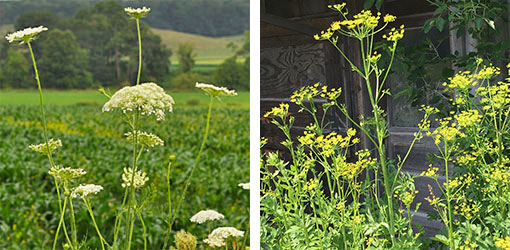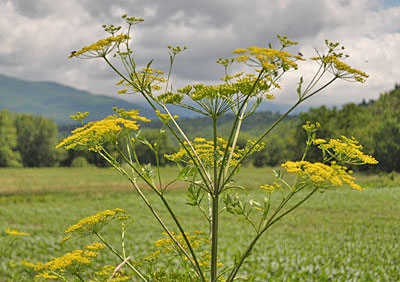Pretty Poison: Wild Parsnip
A walk through a lovely meadow can quickly turn painful if you unwittingly brush against certain plants. Many of us learned to recognize poison ivy and poison oak by the admonition, “Leaves of three, leave it be.” But wild parsnip is another one to watch out for.

Wild parsnip, growing in a meadow. If the plant’s sap comes into contact with your skin, it can cause severe skin damage. Scroll down for ways you can share photos of this and other “plants that hurt.”
A few years ago I was growing flowers for a friend’s wedding and, scanning the roadsides for wildflowers to round out my bouquets, came across a Queen Anne’s lace lookalike with chartreuse yellow flowers. Perfect, I thought, making a mental note of the location. Imagine my surprise when the following morning’s newspaper had a photo of the flowers with a stern warning to steer clear of them. They were wild parsnips (Pastinaca sativa) and sap from their leaves and stems can cause burns worse than any poison ivy rash.
If you get wild parsnip sap on your skin then expose the skin to sunlight, you may end up with blisters that resemble second-degree burns. This plant-and-sun rash is called phytophotodermatitis (phyto=plant, photo=light) and it can result in skin damage so severe as to cause permanent scarring and discoloration.
Get some of the sap in your eyes and it can cause blindness. You won’t know right away that you’ve been exposed; symptoms usually begin about 24 hours after exposure and peak in two or three days. Trips to the emergency room aren’t uncommon. And the rash can reappear years later, even without further exposure. This is serious stuff.
Eliminating the Plants
If you come across any of these plants in the wild, stay away. If you find them in your garden, you’ll want to eradicate them. Start by donning protective clothing. Then, dig up the plants, getting as much root as possible — ideally, early in the season before the plants go to flower and set seeds. Be vigilant and check the area frequently. If you see seedlings or plants that have re-sprouted, cut them off at or below ground level — again wearing protective clothing at all times. You can also spot treat the plants with an herbicide, such as BurnOut® Weed & Grass Killer (active ingredients citric acid and clove oil; safe for organic growing).
Whatever you do, DO NOT USE A STRING TRIMMER! This will send sap-oozing bits of plant flying — some undoubtedly landing on bare skin.
 Queen Anne’s lace, left, is often confused with wild parsnip, right.
Queen Anne’s lace, left, is often confused with wild parsnip, right.
I still shudder to think of what would have happened if I had used those flowers in the bouquets at my friend’s sunny outdoor wedding. I’m just thankful I saw that newspaper article warning of the dangers of the plant. In the spirit of paying it forward, here’s your warning!
Share Your Photos
Help us create a photo album of “plants that hurt” to warn gardeners about plants to avoid. Share photos via Instagram — tag us with @gardeners and #lovegardeners — with the name of the plant and where you took the photo. Include images of poison ivy and other familiar culprits, too, because their appearance varies depending on the time of year and climate.
More Information
- If you have been exposed to wild parsnip sap, wash the affected area thoroughly with soap and water and keep it out of direct sunlight for at least 48 hours. If you see a rash or feel a burning sensation, seek medical care. Wash clothing exposed to sap in a separate laundry load. More wild parsnip information and photos.
- The sap from the garden-variety, cultivated parsnip can also cause the same phytophotodermatitis skin rash. Though it’s not usually as severe, wear protective clothing and use care when harvesting your crop.
- The smaller, woodier roots of wild parsnip are also edible but the toxicity of the sap should discourage all but the most knowledgeable and cautious from considering harvesting them for eating.
- Queen Anne’s lace (Daucus carota) is also known as wild carrot. It’s native to Europe and southwest Asia, but has naturalized in the U.S. and is a common site along roadsides. The relatively small, woody roots are edible. Note, however, that the plant resembles toxic plants, notably poison hemlock, so all but the most knowledgeable should stick with garden-variety carrots.
- Other noxious plants to be aware of: giant hogweed, cow parsnip, and poison ivy. Sap from the garden perennial Dictamnus albus (gas plant) can also cause a burning rash on some people.
Print this Article:
Get the Dirt
Stay up to date on new articles and advice. Please fill out the information below.

